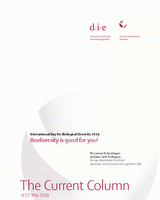International Day for Biological Diversity 2019
Biodiversity is good for you!
Richerzhagen, Carmen / Jean Carlo RodriguezThe Current Column (2019)
Bonn: German Development Institute / Deutsches Institut für Entwicklungspolitik (DIE), (The Current Column of 20 May 2019)
Bonn, 20 May 2019. Contrary to popular belief, biodiversity is not merely “nice to have”; it is in fact existential for human life and sustainable development. The world’s food production indisputably depends on biodiversity. According to the UN’s Food and Agriculture Organization (FAO), about 82 percent of the calories and 60 percent of the protein we consume are provided by a variety of plants. Close to 75 percent of the world’s crops producing fruits and seeds for human consumption depend on pollinators, mainly bees, for sustained production, yield and quality. Furthermore, biodiversity provides the very foundation for human health. It underpins the functioning of the ecosystems on which we depend for fresh water. It aids in regulating climate, floods and disease and provides inputs for medicines. Estimates suggest that around four billion people use natural medicines and that 70 percent of today’s cancer drugs are natural or at least inspired by nature. The International Day for Biological Diversity on 22 May, which this year has the motto “Biodiversity, Our Food, Our Health”, is dedicated to reminding us of these facts.
All the same, biodiversity is being lost at an alarming rate. The latest Global Assessment Report of the Intergovernmental Science-Policy Platform on Biodiversity and Ecosystem Services (IPBES), released in Paris two weeks ago, compiles alarming new evidence. Around one million species face imminent extinction and many more are severely endangered. 145 expert authors from 50 countries have worked on this report over the past three years and systematically reviewed about 15,000 scientific and government sources. They conclude that the unprecedented loss is a direct result of human activities. Changes in land and sea use, direct exploitation of natural resources, anthropogenic climate change, terrestrial as well as marine pollution and invasive species all are direct drivers of biodiversity loss. The report also demonstrates that agriculture, that is crop and livestock production, alone takes up one-third of the world’s land surface and three-quarters of available freshwater resources. Between 1990 and 2015, 290 million hectares of native forest cover have been lost and only 110 million hectares were reforested. Already 33 percent of marine fish stocks are overfished and the contamination of waters by plastic, heavy metals, solvents, toxic sludge and fertilizers has massively increased.
For many years, all over the world attempts have been made to protect biodiversity. Yet, they have not shown significant success. Despite many declarations and conferences, the international targets on biodiversity protection, the so-called Aichi targets, agreed under the Convention on Biological Diversity will not be reached by their 2020 deadline. Next year the convention’s 196 member governments will convene in Beijing, China. The conference is expected to agree on a revised strategy to halt the loss of biodiversity and to adopt new conservation targets. In the run up to this landmark conference, policymakers need to take into account the importance of biodiversity for other development objectives, agreed under the Sustainable Development Goals (SDGs) of the United Nations, just like poverty, hunger and health.
Some of the conservation measures that promise to foster biodiversity conservation and other development goals as food or water security include: biodiversity mainstreaming, and stopping the degradation of land and natural habitats. Biodiversity mainstreaming means the effective integration of biodiversity conservation in cross-sectoral and sectoral plans such as sustainable development plans, agricultural planning, poverty reduction and climate change strategies. For example, in the agricultural sector the EU-LIFE “Biodiversity in Standards and Labels for the Food Sector” project aims at supporting the use of standards and labels in the food sector in order to improve the biodiversity performance. Biodiversity conservation measures that help to halt land degradation and habitat loss are an opportunity to increase food and water security. They can furthermore improve people’s health situation, and even prevent conflicts and migration. For example, conservation agriculture and organic farming can reduce the negative impacts of agricultural production on land and biodiversity and at the same time improve food security through enhanced crop yields.
Biodiversity is determinant for having a safe operating planet in which sustainable development can happen, especially with regard to food and health. In biodiversity and related nature-based solutions society can find (part of) the solution to address climate change, but also to deal with the effects of climate change on food security and health. Therefore, it is vital more than ever to tackle the drivers of biodiversity loss, otherwise humanity will be harshly reminded that money cannot be eaten.

